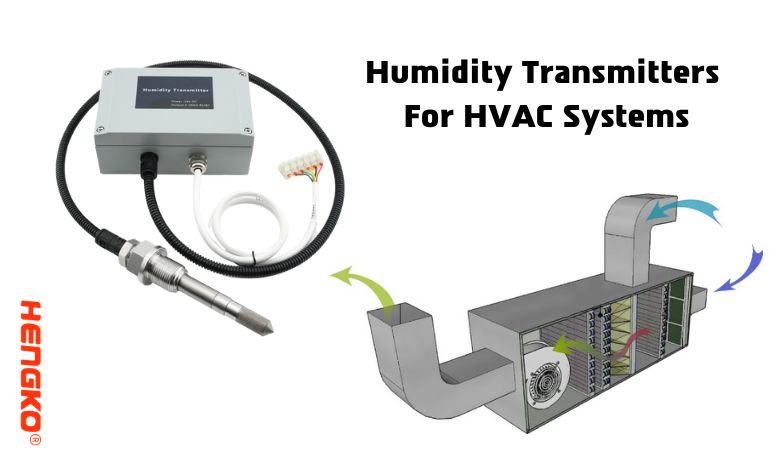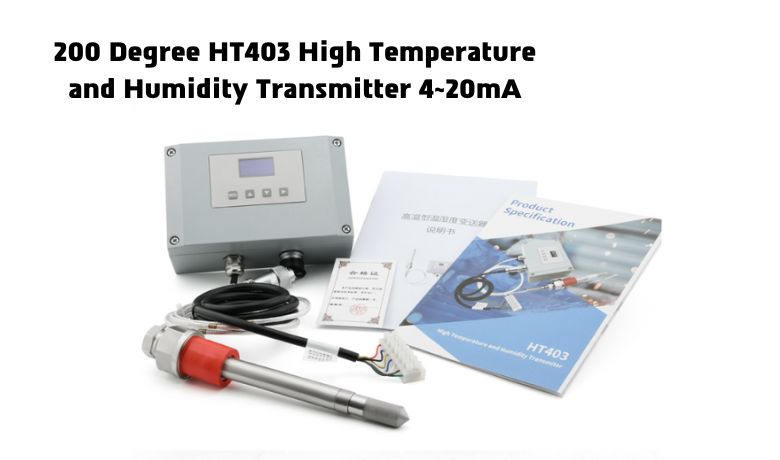Why Temperature and Humidity Transmitters are Critical for HVAC Systems

Introduction Temperature and humidity transmitters are devices used in heating, ventilation, and air conditioning (HVAC) systems to measure and control the temperature and humidity levels in a building. These transmitters are critical in maintaining indoor air quality, energy efficiency, and overall comfort in a space. This blog aims to educate HVAC system owners on the importance of temperature and humidity transmitters and help them choose the right transmitter for their systems.
What are Temperature and Humidity Transmitters?
Temperature and humidity transmitters measure a space's temperature and humidity levels and transmit that information to a control system. The control system then uses the data to adjust the HVAC system's operation to maintain a comfortable and healthy indoor environment.
Various types of temperature and humidity transmitters are available in the market, including analog and digital transmitters and standalone and integrated transmitters. High-quality transmitters typically have automatic calibration, adjustable set points, and real-time monitoring.
Importance of Temperature and Humidity in HVAC Systems Temperature and humidity play a crucial role in indoor air quality and significantly impact human health and comfort. Poor indoor air quality can lead to respiratory problems, headaches, and other health issues, while excessive humidity can lead to mold growth and other structural damage.
Accurate Temperature and humidity control in HVAC systems help to maintain optimal indoor air quality and protect against health and safety hazards. It also leads to energy savings by reducing the need for heating and cooling systems overuse.
What is the Benefit of Temperature and Humidity Transmitters for HVAC Systems?
There are several points benefits of Temperature and humidity transmitters for HVAC systems.
First, transmitters help improve indoor air quality and promote a healthy and comfortable environment by accurately measuring and controlling temperature and humidity levels.
Second, real-time monitoring and control of temperature and humidity levels enhance the performance of HVAC systems by enabling more precise and efficient operation. In turn, helps to reduce energy consumption and saves on energy costs.
Finally, by using temperature and humidity transmitters, HVAC systems can operate more efficiently and effectively, reducing the risk of system failures and breakdowns.
Choosing the Right Temperature and Humidity Transmitter for Your HVAC System When choosing a temperature and humidity transmitter for your HVAC system, there are several factors to consider, including the type of transmitter, accuracy, range, and compatibility with your control system. Additionally, it is important to look for features such as automatic calibration, adjustable set points, and real-time monitoring capabilities.
It is also recommended to choose a high-quality and reliable transmitter from a reputable manufacturer and to consider the technical support and warranty options available with the product.
In conclusion, temperature and humidity transmitters are:
- Critical components of HVAC systems.
- Providing important benefits such as improved indoor air quality.
- Enhanced system performance.
- Increased energy efficiency.
By choosing the right transmitter and maintaining it properly, HVAC system owners can ensure the health and comfort of their indoor environment and reduce energy costs.
As following are some FAQs about Temperature and Humidity Transmitters for HVAC Systems
1. What are temperature and humidity transmitters?
Temperature and humidity transmitters are devices used to measure an environment's temperature and humidity levels and then transmit that data to a control system.
2. Why are they important in HVAC systems?
They are important in HVAC systems because they provide critical information that helps to regulate the temperature and humidity levels in a building, ensuring a comfortable and healthy indoor environment.
3. How do they work?
Temperature and humidity transmitters measure the temperature and humidity levels in an environment and then transmit that data to a control system. The control system then uses that information to adjust the heating and cooling systems and the ventilation systems to maintain a comfortable and healthy indoor environment.
4. What types of temperature and humidity transmitters are available?
There are many different temperature and humidity transmitters available, including wired and wireless transmitters, digital and analog transmitters, and transmitters specific to certain types of environments.
5. What factors should I consider when choosing a temperature and humidity transmitter?
When choosing a temperature and humidity transmitter, you should consider the type of environment that will use it, the accuracy and precision required, the range of measurement, and the type of data transmission.
6. What are the benefits of using temperature and humidity transmitters in HVAC systems?
The benefits of using temperature and humidity transmitters in HVAC systems include improved indoor air quality, increased energy efficiency, reduced maintenance costs, and improved comfort levels.
7. How can temperature and humidity transmitters help improve indoor air quality?
By measuring and controlling the temperature and humidity levels in a building, Temperature and humidity transmitters can help improve indoor air quality by preventing mold growth and reducing the spread of allergens and other harmful particles.
8. How can they increase energy efficiency?
By accurately measuring the temperature and humidity levels in a building, Temperature and humidity transmitters can help increase energy efficiency by allowing the HVAC system to operate more efficiently and effectively.
9. How can they reduce maintenance costs?
Providing accurate data about the temperature and humidity levels in a building, Temperature and humidity transmitters can help reduce maintenance costs by allowing the HVAC system to be optimized for maximum efficiency and minimizing the need for costly repairs.
10. What are some common applications for temperature and humidity transmitters?
Some common applications for temperature and humidity transmitters include HVAC systems in commercial and residential buildings, data centers, museums, and other environments where temperature and humidity control is critical.
11. What are some of the challenges associated with using temperature and humidity transmitters?
Some of the challenges associated with using temperature and humidity transmitters include choosing the right type of transmitter for a specific environment, ensuring accurate data transmission, and maintaining the reliability of the data over time.
12. How can I ensure the accuracy and reliability of my temperature and humidity transmitters?
Suppose you want to ensure the accuracy and reliability of your temperature and humidity transmitters. In that case, it is important to choose a high-quality device, regularly calibrate it, and perform regular
maintenance to keep it in good working order. maybe you can take a time to check HENGKO temperature and humidity transmitters , we introduce you HT407 and 200 Degree HT403 High Temperature
and Humidity Transmitter 4~20mA High precision humidity transmitter for Severe industrial applications, you can choose the right transmitters based on your monitor requires.
13. How often should I calibrate my temperature and humidity transmitter?
The calibration frequency for a temperature and humidity transmitter can vary depending on the device and the environment in which it is used. It is generally recommended to calibrate the device every six months to one year or as required by the manufacturer's specifications.
14. What type of data transmission is used by temperature and humidity transmitters?
Temperature and humidity transmitters can use various types of data transmission, including wired and wireless options, such as RS-485, Ethernet, and WiFi. The type of data transmission used will depend on the specific device and the requirements of the HVAC system.
15. Can temperature and humidity transmitters be integrated into building management systems (BMS)?
Yes, temperature and humidity transmitters can be integrated into building management systems (BMS), allowing real-time monitoring and control of the HVAC system from a central location.
16. Can temperature and humidity transmitters be used in hazardous environments?
Yes, temperature and humidity transmitters can be used in hazardous environments, such as oil and gas facilities, as long as they are certified for use in these environments.
17. Are there any safety concerns associated with temperature and humidity transmitters?
There are typically no safety concerns associated with temperature and humidity transmitters as long as they are installed and used following the manufacturer's specifications.
18. How does the accuracy of temperature and humidity transmitters affect HVAC system performance?
The accuracy of temperature and humidity transmitters is critical for effective HVAC system performance. Suppose the data transmitted by the transmitter is not accurate. In that case, the HVAC system will not be able to regulate the temperature and humidity levels effectively, leading to increased energy consumption and decreased comfort levels.
19. Can temperature and humidity transmitters monitor Temperature and humidity in a laboratory environment?
Yes, temperature and humidity transmitters can monitor temperature and humidity levels in a laboratory environment, ensuring the conditions are suitable for sensitive equipment and experiments.
20. What is the expected lifespan of a temperature and humidity transmitter?
The expected lifespan of a temperature and humidity transmitter can vary depending on the device and the environment in which it is used. A well-maintained transmitter should last several years.
21. Can temperature and humidity transmitters be used in outdoor environments?
Yes, temperature and humidity transmitters can be used in outdoor environments as long as they are designed and certified for use in these conditions.

22. How do Temperature and humidity affect electronic equipment and systems?
High temperatures and high humidity levels can affect electronic equipment and systems by causing corrosion, reducing the reliability of electrical connections, and increasing the risk of electrical failures.
23. What is the impact of Temperature and humidity on indoor air quality?
High temperature and humidity levels can significantly impact indoor air quality, as they can promote the growth of mold and other harmful substances, as well as increase the spread of allergens and other irritants.
24. How can temperature and humidity transmitters help improve energy efficiency in a building?
By providing accurate data about the temperature and humidity levels in a building, Temperature and humidity transmitters can help improve energy efficiency by allowing the HVAC system to operate more efficiently and effectively. It can reduce energy consumption and lower energy costs.
If you have any questions or concerns about Temperature and Humidity Transmitters for HVAC Systems, don't hesitate to reach out to us. Our team of experts is here to assist you and provide the information you need. You can contact us via email at ka@hengko.com and we'll get back to you as soon as possible. Let us help you find the perfect solution for your HVAC system. Email us now!